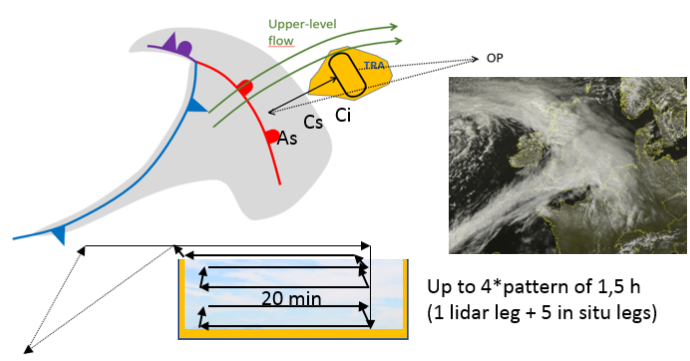Several flight strategies have been proposed by a board of science leaders, meteorologists and other interested persons, in order to optimally address the science goals in given meteorological and operational conditions.
Ice nucleating particles and cirrus formation regimes
The study of cirrus formation processes requires probing of distinct air masses characterized by the distribution of ice nucleating aerosol particles (INPs), including the specific distribution of soot from aviation. An impact of aerosol on the properties of (existing) cirrus may become evident in certain regions and will be compared to suggestions from accompanying model studies.
Strawman pattern
The strawman pattern involves the repeated sampling of a cirrus cloud or a connected system of clouds along the same ground track on different altitudes (flight levels, FL). Vital components are legs below the cloud, in the cloud base, in the cloud top and above the cloud. The legs inside the cloud are dedicated to in situ measurements of cloud particle and aerosol properties, as well as gas phase constituents such as water vapour (relative humidity) and several reactive and greenhouse gases. Legs outside the cloud are performed for measurements of the downward and upward solar (shortwave) and terrestrial (longwave) radiative fluxes. Legs above the cloud further enable remote sounding using lidar, spectral and polarizational optical observations and dropsondes.

Depending on the examined situation, extensions of the strawman pattern may include
- vertical profiling of the inflow regions of warm conveyor belts (WCB)
- probing of the aerosol inflow of convective anvils
- survey of aviation soot upstream and in regions of cirrus formation
- a combination with CALIPSO satellite overpasses
- a more detailed profiling in small vertical steps inside in situ cirrus with slow updraft in pristine and in polluted environments
Low cost TRA pattern
Changes of cirrus properties and thermodynamic structure may be investigated in the nearby TRA (temporary reserved airspace) Allgäu with the aircraft in combination with ground-based observations (by eye or with instruments in Hohenpeißenberg or Munich). This could help understand obviously different cirrus patterns that are transported in typical meteorological situations like warm fronts or high-pressure systems towards the campaign base. A proposed pattern would include one lidar leg and four in situ legs.

